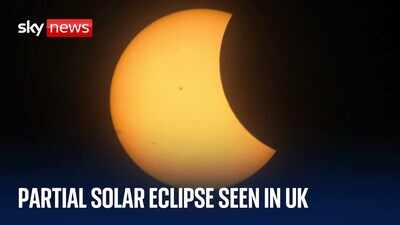Trending
Solar Eclipse 2025: When and Where to see it? Visibility in the US, Canada, and Indonesia. Safety tips on how to watch it?
A deep partial solar eclipse will occur on March 29, 2025, visible in North America and Europe. The best viewing spots include New Brunswick, Quebec, Maine, Greenland, and Iceland. Ensure safety by using eclipse glasses or pinhole projectors while watching this celestial event.
A breathtaking celestial event is set to unfold on Saturday, March 29, 2025, as a deep partial solar eclipse graces the skies across parts of the Northern Hemisphere. While this won’t be a total eclipse, the moon will partially obscure the sun, creating a mesmerizing crescent-like sunrise for those in the best viewing locations.
For skywatchers in North America, this eclipse will be particularly stunning at sunrise, offering a rare chance to witness the eerie "solar horns" effect—where the sun briefly appears as two separate glowing crescents before rising fully into the sky. But where will this phenomenon be most visible? And how can you safely watch it?
Let’s break it down.

When and where will the eclipse be visible?
This partial solar eclipse will be visible across a vast stretch of the Northern Hemisphere, including North America, Europe, parts of Africa, and Russia. However, some locations will have far better views than others.
Best Viewing Locations in the U.S. and Canada
Eastern North America will have some of the most spectacular sunrise views.
New Brunswick and northern Quebec in Canada will experience the deepest eclipse, with the Nunavik region of Quebec seeing an incredible 94% of the sun covered at sunrise.
Maine, U.S. will also be a prime spot, with the sun rising as a crescent shape that momentarily forms the "devil’s horns" effect—a breathtaking and rare sight for early risers.

See More: Solar Eclipse 2025: 5 things to do before, during, and after solar eclipse
Visibility in Europe and other regions
Western and Central Europe will see a partial eclipse later in the morning. The farther northwest you go, the more of the sun will be covered.
Greenland’s west coast will experience up to an 86% eclipse, while Iceland’s Westfjords will max out at 70%.
British Isles:
Dublin, Ireland – 41% eclipse
London, UK – 30% eclipse
Edinburgh, Scotland – 40% eclipse
See more: Saturn Transit in Pisces on March 29, 2025 Live updates; Coincides with Solar Eclipse and Chaitra Amavasya
Mainland Europe:
Paris, France – 23% eclipse
Berlin, Germany – 15% eclipse
Moscow, Russia – 2% eclipse
Indonesia will not be able to witness the solar eclipse.

What is a solar eclipse?
A solar eclipse occurs when the moon passes between the sun and Earth, blocking the sun's light and casting a shadow on Earth, either partially or completely.
Alignment: For a solar eclipse to happen, the Sun, Moon, and Earth must be aligned in a straight line, with the Moon positioned between the Sun and Earth.
New Moon Phase: Solar eclipses can only occur during a new moon phase, when the Moon is between the Earth and the Sun.
Shadows on Earth: The Moon's shadow, consisting of a dark inner part (umbra) and a lighter outer part (penumbra), is cast onto Earth.
See More: What causes a solar eclipse? The science behind it
What is a partial solar eclipse?
A partial solar eclipse occurs when the moon passes between the sun and the Earth, but the three celestial bodies aren't perfectly aligned. As a result, only a portion of the sun is obscured, creating a striking crescent shape in the sky.
These fascinating events can only take place during the new moon phase, offering a captivating spectacle for skywatchers. In 2025, Earth will experience two such eclipses, both of which will be partial solar eclipses.
The first eclipse will occur on March 29, 2025, and will be visible across parts of Europe, Asia, Africa, North and South America, as well as the Atlantic and Arctic Oceans, as detailed by NASA.
The second partial solar eclipse of 2025 will take place on September 21, visible across portions of Australia, Antarctica, and the Pacific and Atlantic Oceans, according to NASA.
How to watch the solar eclipse safely
Viewing a solar eclipse is an incredible experience, but never look directly at the sun without proper eye protection. Here’s how you can safely enjoy the show:
Use solar eclipse glasses – Regular sunglasses won’t protect your eyes. Certified ISO 12312-2 eclipse glasses are required.
Try a pinhole projector – If you don’t have eclipse glasses, you can make a simple pinhole projector to indirectly view the eclipse.
Use a solar filter for cameras & telescopes – If you’re capturing the event, ensure your equipment has a certified solar filter to prevent damage to your eyes and camera sensors.
Never look through binoculars or a telescope without a solar filter – This can cause permanent eye damage in seconds.
End of Article
FOLLOW US ON SOCIAL MEDIA
Visual Stories
Tired of too many ads?









